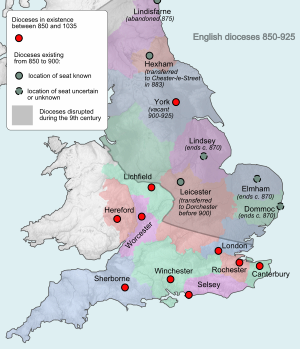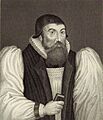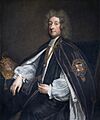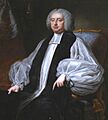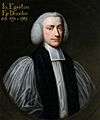Bishop of Durham facts for kids
Quick facts for kids {{{name}}} |
|
|---|---|
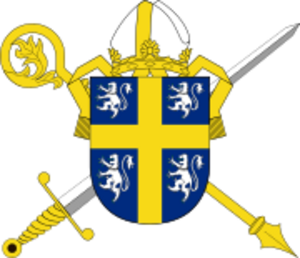
Coat of arms
|
|
| Location | |
| Ecclesiastical province | York |
| Information | |
| Established | 635 (at Lindisfarne) 995 (translation to Durham) |
| Cathedral | Durham Cathedral (since 995) St Mary and St Cuthbert, Chester-le-Street (882–995) Lindisfarne (635–875) |
The Bishop of Durham is a very important leader in the Church of England. This bishop is in charge of the diocese of Durham, which is a special area of churches and communities. The Durham diocese is one of the oldest church areas in all of England.
The Bishop of Durham also has a special role in the country's government. They are a member of the House of Lords, which is part of the UK Parliament. This means they help make decisions for the country. The most recent Bishop of Durham was Paul Butler, who retired in early 2024.
The bishop has a long, fancy title, but most people just use "Bishop of Durham." When they sign documents, they often use "Dunelm." This comes from the old Latin name for Durham.
For a long time, until 1836, the Bishop of Durham had a lot of power. They were not just a church leader but also a ruler in the area. They had control over a region called the County Palatine of Durham. This meant they had powers similar to a king in their own area. Today, the Bishop of Durham still has a special role. They help escort the King or Queen during their coronation ceremony.
The bishops used to live in Durham Castle from the 11th century. In 1832, the castle was given to Durham University to be used as a college. After that, Auckland Castle became the main home for the bishops. They sold it in 2012, but the bishop still has offices there.
Contents
A Look Back: The History of the Bishops
The title of Bishop of Lindisfarne came from Lindisfarne, a small island off the coast of Northumberland, England. This title was first used by the Anglo-Saxons a very long time ago, between the 600s and 900s.
The church of St Cuthbert was very powerful back then. It owned a lot of land. Historians used to think the main church and the bishop's home were in Chester-le-Street for a long time. But newer research suggests they might have been based in Norham for a while. Today, the Roman Catholic Church uses the title "Bishop of Lindisfarne" for a special honorary position.
The first bishop in this line was Saint Aidan. He started the first church area (called a "see") at Lindisfarne in 635.
The Bishop as a Ruler
From the 600s onwards, the bishops of Lindisfarne, and later Durham, had two important jobs. They were church leaders, but they also acted as civil rulers. They were like a local lord, with power similar to the king in their own region. The bishop could appoint local officials and even had their own court.
After the Norman Conquest in 1066, the bishops kept this special power. Their region became known as the County Palatine of Durham. This meant the bishop was both the church leader and the ruler (like an earl) of the county. People sometimes call them "prince-bishops" because of this, even though that term wasn't used back then.
A special site recognized by UNESCO describes the bishops' role. They acted as a "buffer state" between England and Scotland. This meant they helped protect England's northern border. From 1075, the Bishop of Durham could even raise an army, make their own coins, and collect taxes! As long as they stayed loyal to the King of England, they could rule their area almost like an independent leader. They got money from their land but also had to protect the border.
In 1788, a report noted that the bishops could even appoint judges and offer pardons.
This special ruling power lasted a very long time. It was only officially stopped in 1836 by a law called the Durham (County Palatine) Act 1836. After this, the powers went back to the King or Queen. Even today, the Bishop of Durham's coat of arms shows a special crown (a coronet) along with the bishop's hat (a mitre) and a sword. This reminds everyone of their powerful past. The Bishop of Durham still has a seat in the House of Lords, which is a continuation of their historical importance.
Notable Bishops Through Time
Over many centuries, many important people have served as the Bishop of Durham. Here are a few examples from different periods:
Early Bishops of Lindisfarne and Durham
- Aidan (635-651): The very first bishop, a saint who founded the see at Lindisfarne.
- Cuthbert (685-687): Another famous saint who was Bishop of Lindisfarne.
- Aldhun (990-1018): He was the last Bishop of Lindisfarne and the first Bishop of Durham. He moved the church's center to Durham in 995.
Bishops During the Middle Ages
- Ranulf Flambard (1099-1128): An important bishop who helped build Durham Cathedral.
- Hugh de Puiset (1153-1195): A very powerful bishop who was also a cousin of the King.
- Antony Bek (1284-1310): He was the only English person to also hold the title of "Titular Patriarch of Jerusalem."
Bishops After the Reformation
- Cuthbert Tunstall (1530-1552, 1554-1559): He was bishop during a time of big changes in the church. He was removed from his role when he refused to accept the new rules under Queen Elizabeth I.
- John Cosin (1660-1672): He became bishop after a period when the diocese was temporarily closed during the English Civil War.
Modern Bishops (Since 1836)
- J. B. Lightfoot (1879-1889): A very respected scholar and theologian.
- Michael Ramsey (1952-1956): He later became the Archbishop of Canterbury, the most senior bishop in the Church of England.
- Justin Welby (2011-2013): He also went on to become the Archbishop of Canterbury.
- Paul Butler (2014-2024): The most recent Bishop of Durham.
Images for kids


